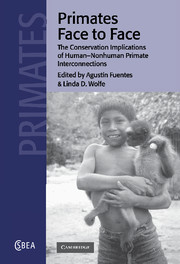Book contents
- Frontmatter
- Contents
- List of contributors
- Foreword
- Acknowledgements
- Introduction
- Part 1 Science and nonhuman primates
- Part 2 Cultural views of nonhuman primates
- Part 3 Conservation of nonhuman primates
- Part 4 Government actions, local economies and nonhuman primates
- 13 The primatologist as minority advocate
- 14 Monkey business? The conservation implications of macaque ethnoprimatology in southern Thailand
- 15 Rhesus macaques: a comparative study of two sites, Jaipur, India, and Silver Springs, Florida
- Index
15 - Rhesus macaques: a comparative study of two sites, Jaipur, India, and Silver Springs, Florida
Published online by Cambridge University Press: 20 October 2009
- Frontmatter
- Contents
- List of contributors
- Foreword
- Acknowledgements
- Introduction
- Part 1 Science and nonhuman primates
- Part 2 Cultural views of nonhuman primates
- Part 3 Conservation of nonhuman primates
- Part 4 Government actions, local economies and nonhuman primates
- 13 The primatologist as minority advocate
- 14 Monkey business? The conservation implications of macaque ethnoprimatology in southern Thailand
- 15 Rhesus macaques: a comparative study of two sites, Jaipur, India, and Silver Springs, Florida
- Index
Summary
Introduction
Rhesus macaques (Macaca mulatta) are descendants of the cercopithecine monkeys who migrated to Asia from Africa about 3 million years ago and adapted to the range of landscapes and climates of Asia (Fleagle, 1999; Szalay and Delson, 1979). Modern Asian macaques are highly adaptable primates and in the recent past were distributed from eastern Afghanistan through to China and south to the Islands of Indonesia. Asian macaques are also found from Sri Lanka to the islands of Japan (Wolfheim, 1983). Rhesus monkeys were once found from eastern Afghanistan to southern China and from the middle of India to northern Vietnam, but in recent times their distribution has shrunk because of habitat distribution and the removal of monkeys for food and export (Wolfheim, 1983).
Rhesus macaques live in multimale–multifemale troops that have been reported to range from a minimum of 10 monkeys to over 100. There are usually more females than males in a troop because about half of the males choose a solitary lifestyle rather than living in a troop. Females remain in their natal troops and form subgroups composed of females and males based on kinship and friendships. Males leave their natal troops around the age of 4 years and either remain solitary or join a new troop.
- Type
- Chapter
- Information
- Primates Face to FaceThe Conservation Implications of Human-nonhuman Primate Interconnections, pp. 310 - 330Publisher: Cambridge University PressPrint publication year: 2002
- 18
- Cited by



